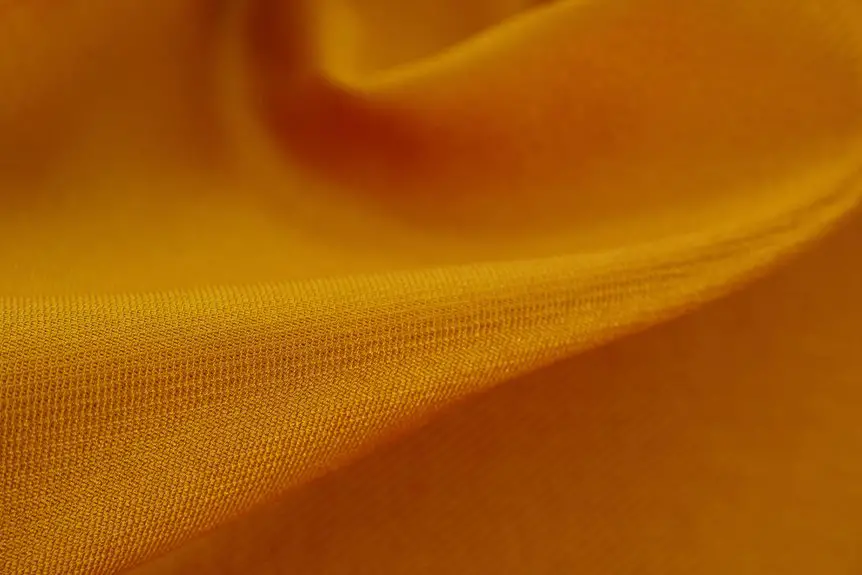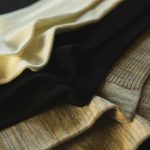If you’re looking for a fabric that balances softness, durability, and comfort, ringspun cotton blends like 80/20 or 60/40 polyester are a solid choice. You’ll get the smooth, strong feel of ringspun cotton combined with polyester’s wrinkle resistance and moisture management. These blends hold their shape better and last longer than regular cotton-polyester fabrics. Want to know how these blends perform in daily wear and what makes them popular? Keep exploring to find out more.
Table of Contents
Key Takeaways
- Ringspun cotton improves softness and breathability in polyester blends like 80/20 and 60/40, enhancing overall comfort.
- The twisted fibers of ringspun cotton add durability and reduce pilling in polyester blend fabrics.
- Blending ringspun cotton with polyester balances moisture management and wrinkle resistance for easier garment care.
- Ringspun cotton-polyester blends maintain shape better and resist sagging compared to regular cotton blends.
- Cost-effectiveness improves with polyester blends, while ringspun cotton ensures higher fabric quality and longevity.
Understanding Ringspun Cotton: Key Characteristics
Ringspun cotton stands out for its unique spinning process, which twists and thins the cotton fibers to create a stronger, softer yarn.
When you wear garments made from ringspun cotton, you’ll notice the fabric feels smoother and more durable than regular cotton. It’s less prone to pilling and offers better breathability, making it comfortable for all-day wear.
The fibers are tightly wound, so the fabric maintains its shape and resists stretching over time. If you appreciate softness combined with resilience, ringspun cotton delivers both.
Plus, because it’s more refined, it often looks more polished and high-quality. Understanding these key characteristics helps you see why ringspun cotton is favored for premium apparel and why it’s a valuable component in fabric blends.
Overview of Polyester Blends and Their Uses
Polyester blends combine the best traits of polyester with natural fibers like cotton to create fabrics that balance comfort, durability, and performance. When you choose these blends, you get a versatile material suited for various applications.
Here’s what makes polyester blends stand out:
- Durability – Polyester adds strength and resistance to wear, so your garments last longer without losing shape.
- Moisture-Wicking – These blends often manage moisture better than pure cotton, keeping you dry during activities.
- Easy Care – Polyester blends resist wrinkles and shrinkage, making your clothes easier to maintain.
Whether you’re picking out activewear, casual tees, or work uniforms, polyester blends offer a practical solution that fits your lifestyle while delivering comfort and resilience.
How Ringspun Cotton Enhances Fabric Softness
Although cotton fibers are naturally soft, the spinning process can make a big difference in how a fabric feels against your skin.
Ringspun cotton involves twisting and thinning the fibers, creating a finer, stronger yarn compared to regular cotton. When this yarn blends with polyester, you get a fabric that feels noticeably softer and smoother.
You’ll appreciate how ringspun cotton reduces the roughness often found in polyester blends, making the fabric more comfortable for daily wear. The tighter twist of ringspun cotton also helps eliminate the coarse texture, giving you a gentle touch without sacrificing breathability.
Durability Comparison: Ringspun Cotton vs. Regular Cotton
When you compare two types of cotton yarns, you’ll notice that ringspun cotton stands out for its strength and durability.
Unlike regular cotton, ringspun fibers are twisted and thinned, creating a tighter, stronger thread.
This difference means:
- Ringspun cotton resists pilling and tearing better, keeping your fabric intact longer.
- The smooth, tightly wound fibers reduce wear from washing and daily use.
- Regular cotton, while soft, tends to break down faster under stress, leading to fuzziness and thinning.
Benefits of Combining Ringspun Cotton With Polyester
When you combine ringspun cotton with polyester, you get fabric that’s both soft and strong.
This blend boosts durability while managing moisture better than pure cotton.
You’ll enjoy the comfort of ringspun cotton with the added benefits polyester brings.
Enhanced Fabric Durability
Because ringspun cotton fibers are finer and smoother, combining them with polyester greatly boosts fabric durability. When you choose a ringspun cotton-polyester blend, you get a fabric that not only feels soft but also stands up to wear and tear better than pure cotton.
Here’s how this blend enhances durability:
- Resistance to Pilling – The smoother ringspun fibers reduce friction, minimizing fabric pills.
- Strength Retention – Polyester adds tensile strength, helping the fabric hold up through frequent washing and stretching.
- Shape Maintenance – The blend resists shrinking and wrinkling, so your garments keep their form longer.
Improved Moisture Management
Although cotton naturally absorbs moisture, it can feel heavy and damp during intense activity.
When you combine ringspun cotton with polyester, you get a fabric that manages moisture much better. Polyester wicks sweat away from your skin, helping it evaporate quickly, so you stay drier and more comfortable.
Ringspun cotton adds breathability and softness, preventing that clammy feeling you’d get with pure cotton. This blend creates a balance where moisture doesn’t linger, reducing the chance of irritation or chafing.
Softness Meets Strength
Combining ringspun cotton with polyester gives you a fabric that balances softness and durability in a way pure materials can’t match.
When you wear this blend, you enjoy the plush feel of ringspun cotton alongside polyester’s toughness. This combination makes your clothes comfortable yet long-lasting.
Here’s how you benefit:
- Softness: Ringspun cotton’s fine fibers create a smooth, gentle texture against your skin.
- Strength: Polyester adds resilience, preventing wear and tear during frequent use and washing.
- Shape retention: The blend resists stretching or shrinking, keeping your garments looking fresh over time.
Breathability and Moisture Management in Ringspun Blended Fabrics
When you wear ringspun cotton blended with polyester, you benefit from enhanced breathability and moisture management that neither fabric could achieve alone.
Ringspun cotton fibers, being finer and more tightly twisted, create a softer, more porous fabric that allows air to circulate easily. This natural breathability helps wick moisture away from your skin, keeping you cooler and drier.
Finer, tightly twisted ringspun cotton fibers create breathable, soft fabric that wicks moisture, keeping you cool and dry.
Meanwhile, polyester’s hydrophobic properties speed up moisture evaporation, so sweat doesn’t linger. Together, the blend balances comfort and performance, making it ideal for activewear or everyday use.
You’ll notice the fabric dries faster than pure cotton but remains comfortable against your skin, thanks to ringspun cotton’s natural softness.
This synergy makes ringspun cotton-polyester blends a smart choice when breathability and moisture control matter.
Impact of Ringspun Cotton on Fabric Stretch and Recovery
You’ll notice ringspun cotton adds a bit more stretch to polyester blends, making the fabric feel more flexible.
This extra stretch doesn’t just improve comfort—it also helps the fabric bounce back after being stretched.
As a result, your clothes last longer and keep their shape better over time.
Stretchability Enhancement Effects
Although polyester provides durability, ringspun cotton enhances fabric stretch and recovery in blends by introducing a softer, more flexible fiber structure.
When you wear fabrics combining ringspun cotton with polyester, you’ll notice increased comfort and better movement.
Here’s how ringspun cotton improves stretchability:
- Soft fiber texture: Ringspun cotton’s fine, tightly twisted fibers allow the fabric to bend and flex more easily without feeling stiff.
- Improved elasticity: The cotton fibers add a natural give, helping the fabric stretch further before reaching its limit.
- Enhanced recovery: After stretching, the fabric snaps back more smoothly, maintaining its shape longer during wear.
This combination makes your garments feel less restrictive while keeping the strength polyester offers.
Recovery and Durability Benefits
Beyond enhancing stretchability, ringspun cotton plays a key role in improving how polyester blends recover their shape and hold up over time.
When you choose ringspun cotton in blends like 80/20 or 60/40, you get fabric that resists sagging and bagging after repeated wear. The tightly twisted fibers add resilience, helping the fabric bounce back to its original form instead of stretching out permanently. This means your clothes maintain a crisp, neat appearance longer, even with frequent use and washing.
Additionally, ringspun cotton reinforces durability by reducing fiber breakage, so your garments last beyond typical wear cycles.
Care and Maintenance Tips for Ringspun Cotton Polyester Blends
Caring for ringspun cotton polyester blends takes just a few simple steps to keep your garments looking fresh and lasting longer.
To maintain their softness and durability, follow these key tips:
- Wash with Care: Use cold water and a gentle cycle to prevent shrinking and color fading. Avoid bleach, which can damage fibers.
- Dry Properly: Tumble dry on low or air dry to minimize wrinkles and reduce wear. High heat can weaken fibers and cause shrinkage.
- Iron When Needed: If ironing is necessary, use a low heat setting and avoid direct contact with prints or embellishments to preserve fabric integrity.
Common Applications of 80/20 and 60/40 Ringspun Cotton Blends
Ringspun cotton blends like 80/20 and 60/40 offer a versatile mix of comfort and durability that suits many uses. You’ll find these blends in apparel, home textiles, and promotional products thanks to their softness and wrinkle resistance. Choosing between 80/20 and 60/40 depends on how much polyester’s strength and moisture-wicking you want.
| Application | 80/20 Blend Use | 60/40 Blend Use |
|---|---|---|
| Casual Wear | T-shirts, hoodies | Sweatshirts, activewear |
| Work Uniforms | Durable, breathable shirts | Heavy-duty, longer-lasting |
| Home Textiles | Pillowcases, bedsheets | Blankets, upholstery fabric |
| Promotional Items | Soft, vibrant print surfaces | More durable, colorfast items |
This table helps you match blends to your specific needs effectively.
Cost Considerations When Choosing Ringspun Cotton Blends
When weighing your options for cotton blends, cost plays an essential role in the decision-making process. You want a fabric that balances quality and budget without compromising your product’s appeal.
Here are three key cost considerations to keep in mind:
- Material Expense: Ringspun cotton tends to be pricier than regular cotton due to its finer, softer yarns. Blending it with polyester can reduce overall costs while maintaining some softness.
- Durability vs. Price: Higher polyester content often lowers the price and increases durability but can affect comfort. Finding the right ratio is critical to meet your price and quality goals.
- Production Costs: Blending fibers may require specialized machinery or processes, influencing manufacturing expenses. Always factor this into your budget when choosing your blend.
Environmental Impact of Ringspun Cotton and Polyester Blends
You’ll want to contemplate how ringspun cotton and polyester blends compare in sustainability before making a choice.
Think about how biodegradable each material is and the energy required during manufacturing. These factors play a big role in their overall environmental impact.
Sustainability Comparison
Although polyester blends offer durability and affordability, they come with significant environmental costs that you should consider.
Ringspun cotton, while resource-intensive to grow, is a natural fiber and renews more sustainably than synthetic polyester.
When comparing their sustainability, focus on these points:
- Resource Use: Ringspun cotton requires water and pesticides, but polyester depends on fossil fuels, a non-renewable source.
- Energy Consumption: Producing polyester uses more energy than processing cotton fibers.
- Microplastic Pollution: Polyester sheds microplastics during washing, which harm aquatic ecosystems, unlike cotton.
Biodegradability Factors
Understanding the sustainability differences between ringspun cotton and polyester blends leads naturally to examining their biodegradability.
Ringspun cotton, being a natural fiber, breaks down relatively quickly in the environment, usually within a few months under the right conditions. This means if you choose garments with higher cotton content, they’ll have less long-term environmental impact after disposal.
On the other hand, polyester is a synthetic fiber derived from petroleum and can take decades or even centuries to decompose. When you wear polyester blends like 80/20 or 60/40, the cotton portion biodegrades, but the polyester remains, contributing to microplastic pollution.
Manufacturing Energy Use
When you compare the manufacturing energy use of ringspun cotton and polyester blends, you’ll find notable differences that affect their environmental impact.
Polyester production relies heavily on fossil fuels, consuming significant energy, while ringspun cotton requires less energy but depends on water and land resources. Blending these fibers changes the energy dynamics.
- Polyester fibers: Produced from petroleum, requiring high heat and energy-intensive processes.
- Ringspun cotton: Involves mechanical spinning with moderate energy but less than synthetic fiber production.
- Blends (e.g., 80/20 & 60/40): Combine energy demands, where polyester dominates overall consumption but cotton reduces total fossil fuel use.
Understanding these factors helps you make informed choices about the environmental cost of your fabric blends.
Consumer Preferences and Market Trends for Ringspun Cotton Fabrics
Since consumers increasingly look for comfort and durability in their clothing, ringspun cotton fabrics have gained significant popularity in the market.
You’ll notice that people prefer ringspun cotton blends because they feel softer and last longer than regular cotton. The finer, stronger yarn creates a smooth texture that appeals to those who want quality without sacrificing style.
Market trends show a steady rise in demand for blends like 80/20 and 60/40, which balance the breathability of cotton with polyester’s wrinkle resistance and durability.
Blends like 80/20 and 60/40 offer the perfect mix of cotton’s breathability and polyester’s durability.
As a shopper, you’ll find these fabrics in activewear, casual tees, and branded apparel. Manufacturers respond by offering more ringspun options, knowing consumers value the enhanced comfort and longevity these blends provide.
Frequently Asked Questions
How Does Ringspun Cotton Affect Dye Absorption in Polyester Blends?
You’ll notice ringspun cotton absorbs dye more evenly, giving vibrant colors, but polyester resists dye. In blends, ringspun cotton boosts dye uptake, making colors richer, though polyester’s presence means colors might be less intense overall.
Are Ringspun Cotton Polyester Blends Hypoallergenic?
Sensitive skin? You’ll find ringspun cotton-polyester blends fairly friendly, minimizing irritation. While not entirely hypoallergenic, they help hinder harsh reactions compared to rougher fabrics. Always test to guarantee your skin stays safe and snug.
Can Ringspun Cotton Blends Be Used for Athletic Wear?
You can definitely use ringspun cotton blends for athletic wear since they’re soft, breathable, and durable. They wick moisture better than pure cotton, keeping you comfortable during workouts while maintaining a great fit and feel.
What Is the Typical Shrinkage Rate for Ringspun Cotton Polyester Blends?
You’ll usually see about 3-5% shrinkage in ringspun cotton polyester blends after the first wash. Polyester helps reduce shrinking compared to 100% cotton, but you should still wash in cold water and air dry when possible.
Do Ringspun Cotton Blends Resist Pilling Better Than Other Blends?
Like a shield against wear, ringspun cotton blends resist pilling better than many others. You’ll notice fewer fuzz balls since the tightly twisted fibers hold up well, keeping your fabric smooth and looking newer longer.







